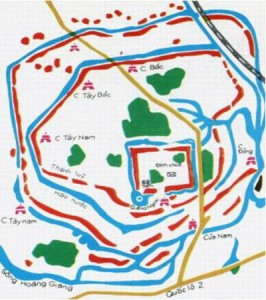Co Loa Citadel (Vietnamese: Thành Cổ Loa) is a citadel built near Phong Khe, about 20km to the North of today’s Hanoi, during the end of the Hong Bang Dynasty (about 257 BCE). The fortress is a spiral-shaped complex of the then new capital. Its name is derived from the Sino-Vietnamese 古螺, meaning “old spiral.” The site has been the source of various relics of the Dong Son culture of the Bronze Age.
According to folklore, Thục Phán (An Dương Vương) defeated the last of the Hung kings in 257 BCE and founded the kingdom of Âu Lạc, choosing the site of Co Loa as his capital (See The Hung King Temple Festival). Co Loa is a very large site and is the dominant presence in the northern floodplain of the Red River Delta, which would have required a large amount of labour and resources to have built in its time.
 The site consists of two outer sets of ramparts and a citadel on the inside, of rectangular shape.
The site consists of two outer sets of ramparts and a citadel on the inside, of rectangular shape.
The outer rampart comprises a perimeter of 8 km and is lined with guard towers. The ramparts still stand up to 12 m high and are 25 m in width at their base. Archaeologists have estimated that over two million cubic metres of material were moved in order to construct the entire fortress, including moats that were fed by the Hoang River.
Excavations made by archaeologists have revealed Dong Son style pottery that had stratified over time under the walls, while a drum was found by chance by Nguyen Giang Hai and Nguyen Van Hung. The drum included a hoard of bronze objects. The rarity of such objects in Southeast Asia and the range found at Co Loa is believed to possibly be unique.
The drum itself is one of the largest Bronze Age drums to have been recovered from the Red River Delta, standing 57 cm high and boasting a tympanum with a diameter of 73.6 cm. The drum itself weighs 72 kg and contains around 200 pieces of bronze, including 20 kg of scrap pieces from a range of artefacts. These include socketed hoes and ploughshares, socketed axes, and spearheads.
The artefacts are numerically dominated by the ploughshares, of which there are 96. Six hoes and a chisel were in the set. There were 32 socketed axes of various shapes, including a boat shaped axehead. This was almost a replica to a clay mound found in the grave of the bronze metalworker at Lang Ca.
Sixteen spearheads, a dagger and eight arrowheads were also found. One spearhead generated special interest because it was bimetallic, with an iron blade fitting into a bronze socket.
[Source]
